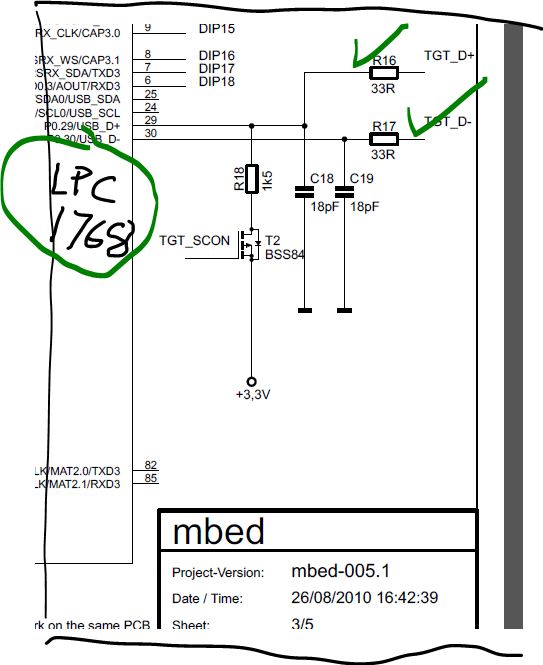Guys,
I've been prototyping new hardware based on the LPC11U24 and I believe I've found a bug on the official mbed LPC11U24, which worries me especially considering many people (such as myself) base our custom designs based on the implied best-practices of the mbed design.
The bug is related to the termination of the USB D+/D- lines connected to the LPC11U24 and (subsequently the broken-out pins D+/D- on the actual mbed).
In almost every other USB implementation I've been able to dig up from multiple vendors (including the LPC1768 mbed!), the resistors and low-pF value caps form a low-pass filter to help reduce interference. In the case of the mbed LPC11U24, it appears the resistors vs capacitors are accidentally reversed!
Have a look at my screenshot with an arrow pointing to where I believe the resistors should actually be. As I mentioned, the mbed LPC1768 does this correctly, as do the D+/D- lines on the mbed magic chips on BOTH mbeds!
BUT, I'm not 100% confident about the validity of my statements because 1) I'm a USB hardware novice and 2) I imagine the @mbed went through multiple levels of review compared to my very novice self. My take on it is that of course the USB features certainly still work most of the time, but the filter is basically reversed, and half as effective at stopping incoming interference (assuming the device at the other end of the connection has the proper termination). In harsh conditions, this *could* negatively affect reliability.
A picture always helps. Here is the mbed LPC11U24 schematic with what I believe are errors:

Here is the mbed LPC1768 in comparison which I believe is OK:

I would be most grateful if the people @mbed could comment on this, because I have a few designs that I was about to send off for prototyping... but I want to get this right!
PS also notice the 1.5k resistor and BSS84 (T2) is also inconsistently positioned between the two mbed designs!
Guys,
I've been prototyping new hardware based on the LPC11U24 and I believe I've found a bug on the official mbed LPC11U24, which worries me especially considering many people (such as myself) base our custom designs based on the implied best-practices of the mbed design.
The bug is related to the termination of the USB D+/D- lines connected to the LPC11U24 and (subsequently the broken-out pins D+/D- on the actual mbed).
In almost every other USB implementation I've been able to dig up from multiple vendors (including the LPC1768 mbed!), the resistors and low-pF value caps form a low-pass filter to help reduce interference. In the case of the mbed LPC11U24, it appears the resistors vs capacitors are accidentally reversed!
Have a look at my screenshot with an arrow pointing to where I believe the resistors should actually be. As I mentioned, the mbed LPC1768 does this correctly, as do the D+/D- lines on the mbed magic chips on BOTH mbeds!
BUT, I'm not 100% confident about the validity of my statements because 1) I'm a USB hardware novice and 2) I imagine the @mbed went through multiple levels of review compared to my very novice self. My take on it is that of course the USB features certainly still work most of the time, but the filter is basically reversed, and half as effective at stopping incoming interference (assuming the device at the other end of the connection has the proper termination). In harsh conditions, this *could* negatively affect reliability.
A picture always helps. Here is the mbed LPC11U24 schematic with what I believe are errors:
Here is the mbed LPC1768 in comparison which I believe is OK:
I would be most grateful if the people @mbed could comment on this, because I have a few designs that I was about to send off for prototyping... but I want to get this right!
PS also notice the 1.5k resistor and BSS84 (T2) is also inconsistently positioned between the two mbed designs!